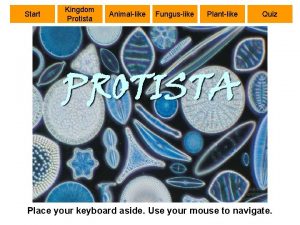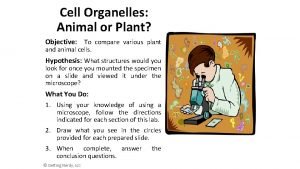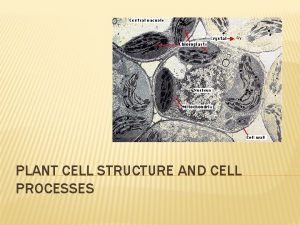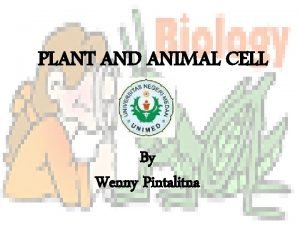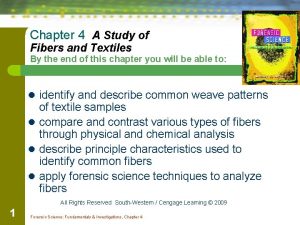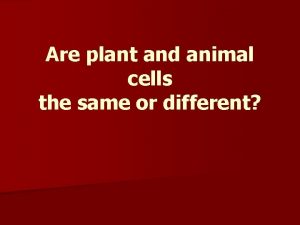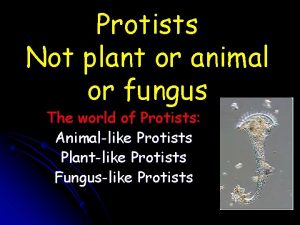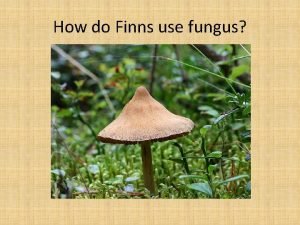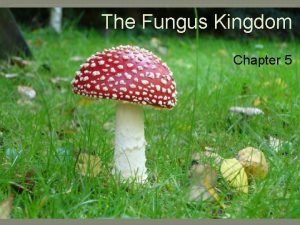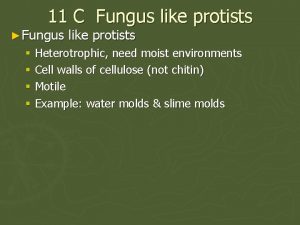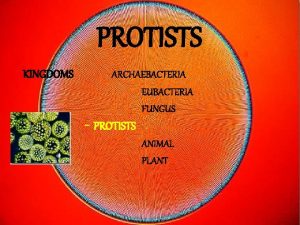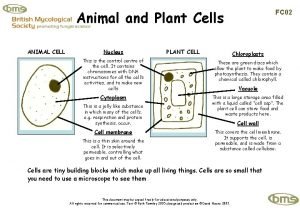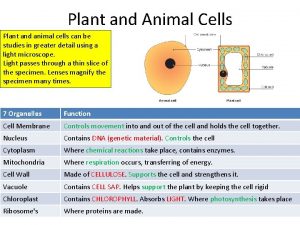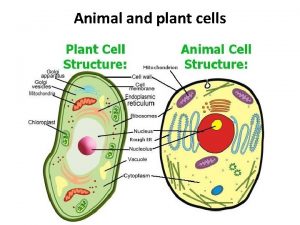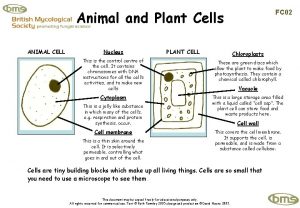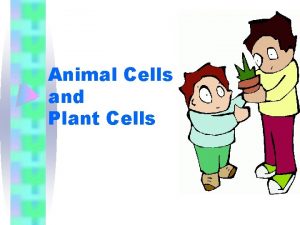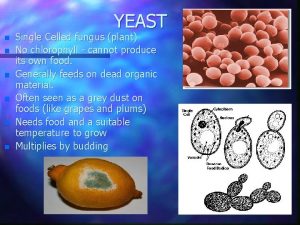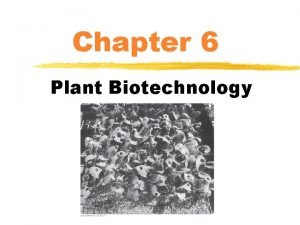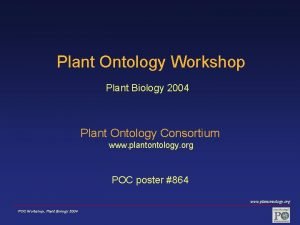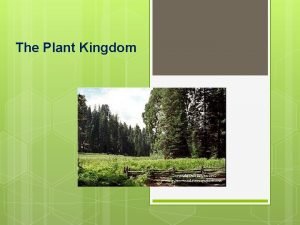A fungus is not a plant Fungus Animal






























- Slides: 30

A fungus is not a plant. Fungus Animal Plant Chitin yes no Food storage glycogen starch


Multicellular fungi consist of mycelium, which are made up of strands called hyphae. Hyphae have enormous surface areas. Absorbs food from environment. Prone to drying out.

Most of “body” of fungus is feeding structure. Only reproductive body typically exposed to air. Thick, fleshy structure of “shroom” prevents drying out.

Reproductive structure produces spores

Ascomycetes have spores in sacs. Basidiomycetes have spores on clubs.

In fungi, cytoplasm of two individuals fuses, but their nuclei may remain separate for a long time.

Fungal phylogeny is a work in progress! No point in learning this now, will change.

Importance of Fungi: 1. Decomposers 2. Mycorrhizae 3. Lichens 4. Economic Impacts

Fungi as decomposers Basidiomycete fungi are the only organisms that can completely digest the lignin in wood. Fungi serve an essential role in the carbon cycle.

Adaptations helping with decomposition: 1. Extracellular digestion 2. 3. Only small molecules can cross plasma membranes. Secreted enzymes break down large molecules.

Adaptations helping with decomposition: 2. Lignin peroxidase 3. Enzyme catalyzes removal 4. of a single electron; creating a 5. highly reactive atom. 6. 7. 8. 9. 10. 11. “Enzymatic combustion” Uncontrolled oxidation reaction breaks up polymer. (Most enzymatic reactions very specific, but lignin itself highly random). 12. Randomness of reaction means 13. that E from oxidation can’t be 14. harnessed.

Adaptations helping with decomposition: 3. Cellulose digestion 4. By cutting up lignin, fungi 5. gain access to cellulose. 6. 7. 8. 9. The cellulase enzymes digest cellulose into glucose, which can be used for food.

Importance of Fungi: 1. Decomposers 2. Mycorrhizae 3. Lichens 4. Economic Impacts

Fungi as partners with plants: Mycorrhizae Importance of mycorrhizae discovered in ‘ 70’s. Failure of pine plantations key observation.

Fungi as partners with plants: Mycorrhizae EM fungi on most trees in temperate & boreal forests. Hyphae penetrate dead leaves, twigs. Release enzymes that cleave peptide bonds. Provide N to plant in exchange for C.

Fungi as partners with plants: Mycorrhizae AMF important in tropics and grasslands, on 80% of plants. Ancient; fossil from 400 mya. Provide phosphorus to plant in exchange for C.


Importance of Fungi: 1. Decomposers 2. Mycorrhizae 3. Lichens 4. Economic Impacts

Fungi as colonizers: lichens

Lichens are composed of fungal hyphae and a layer of autotrophic green algae or cyanobacteria Colonize bare rock following glaciation. First stage in soil building.

Importance of Fungi: 1. Decomposers 2. Mycorrhizae 3. Lichens 4. Economic Impacts

Of course, the most important economic impacts are those already mentioned.

Fungi rot crops.

A fungus called ergot is associated with accusations of witchcraft. Ergot poisoning causes convulsions, shaking, or spasms and sometimes hallucinations or gangrene. Ergot is the original source from which LSD first isolated. http: //www. botany. hawaii. edu/faculty/wong/BOT 135/LECT 12. HTM

Fungi are thought to contribute to the worldwide decline of amphibian populations.

A fungus has caused the virtual extinction of the American chestnut. Note the man, to show scale.

The first antibiotic was derived from Penicillium. This is also the genus used to make blue cheeses. Penicillium roquefortii is used in the manufacture of blue cheeses e. g. Roquefort, Gorgonzola, Stilton, etc. During the fermentation process the fungus spores are injected into the curd. By the way, the blue in the blue-cheese is caused by the pigment in the spores of the fungus. So, when you eat blue cheese you are consuming spores by the million. http: //www. virtualmuseum. ca/Exhibitions/Mushroom/English/Lives/index. html

Yeast is the workhorse of eukaryote genetics. Yeasts are also essential to the production of wine, beer and bread.

Some fungi are just really cool.
 Quiz 2: animal-like protists
Quiz 2: animal-like protists English 9 vocabulary unit 1
English 9 vocabulary unit 1 Define plant breeding
Define plant breeding Taichum
Taichum Plant introduction in plant breeding
Plant introduction in plant breeding Tronsmo plant pathology and plant diseases download
Tronsmo plant pathology and plant diseases download Tronsmo plant pathology and plant diseases download
Tronsmo plant pathology and plant diseases download Tronsmo plant pathology and plant diseases download
Tronsmo plant pathology and plant diseases download Whats the difference between animal and plant cells
Whats the difference between animal and plant cells Whats the difference between plant and animal cells
Whats the difference between plant and animal cells Venn diagram plant and animal cell
Venn diagram plant and animal cell Plant cell vs animal cell venn diagram
Plant cell vs animal cell venn diagram Cell theory foldable
Cell theory foldable Types of organelles
Types of organelles Plant cell structure
Plant cell structure Plant and animal cell
Plant and animal cell Plant and animal cell objectives
Plant and animal cell objectives Plant cell under electron microscope labelled
Plant cell under electron microscope labelled Plant or animal cell
Plant or animal cell Perixomes
Perixomes Plankton is animal or plant
Plankton is animal or plant Chapter 4 notes fiber evidence
Chapter 4 notes fiber evidence Whats the difference between plant and animal cells
Whats the difference between plant and animal cells Plant and animal cells
Plant and animal cells Plant and animal cell jeopardy
Plant and animal cell jeopardy Which cell is larger plant or animal
Which cell is larger plant or animal Idealized animal cell
Idealized animal cell Label
Label Animal cell labeled
Animal cell labeled Plant vs animal cells
Plant vs animal cells Whats the difference between plant and animal cells
Whats the difference between plant and animal cells
